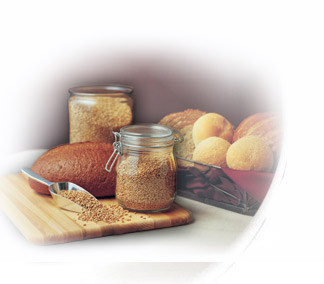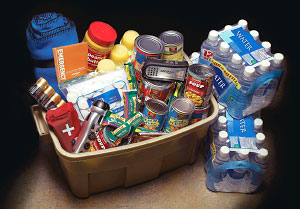My food storage isn’t quite where I want it to be yet, since we’ve relied on it a bit and not replenished as fast as I’d like. We have the basics to sustain life and enough to get us through for ordinary emergencies, but let’s face it, when times are hard, you want more than just foods that sustain life.
This week, I’ve been too sick to go shopping and we’ve been hit with a major snowstorm as well. I haven’t been to a store in a few weeks. We won’t starve, since there is plenty of food in the freezer and in the pantries, but I realized the kinds of foods I want when I don’t feel good are not on my shelves—I used them up within days of getting sick. Since my husband is putting in long hours at work, we’re making do—but not with the foods I want.
I’ve been thinking lately of putting together some specialized emergency kits for specific types of situations. When our power goes out, I need foods that can be cooked on our camp stove, but most of my regular cooking gets done in the oven and tends towards casseroles, because I don’t like to cook. When we’re without water (which happens often where we live), I need foods that don’t require very many dishes, since I don’t want to use too much water for washing them. When I’m sick, I need some simple meals that don’t require a lot of handling, since I am cooking for my husband as well, and that are easy, since I don’t feel good. In addition, I often want gentle foods for upset stomachs or tempting foods for no-appetite days. Invariably, those are the foods I haven’t stocked up on recently.
I’ve been working on menus of shelf-stable meals so I can have all the ingredients on hand if I get sick or miss the announcement of a snow storm. The plan is to put together a few boxes that contain everything I need for one week of the situations I’m preparing for, along with menus and recipes. During these emergency times, I often find it hard to think and, if I’m sick, I have no energy. Being able to pick up a box and move it to my kitchen or to my camp stove station would make life so much easier. The camp stove box will include paper dishes that can be tossed, since our electric water well doesn’t work if we don’t have electricity.
To prepare your box, walk through a day in the setting you’re preparing for—in your imagination, of course. Try to picture yourself making each meal and be aware of what you have to do to gather supplies, cook, and clean up. Write everything down so you don’t end up surprised. For instance, do you have a manual can opener if there is no electricity?
Although you may have a generator, try to prepare as if you don’t. During Hurricane Sandy, some people had their generators stolen. In addition, many places were rationing gas—if the gas stations were even open. Presume you might not be able to use it.
 Although many people think of food storage as being for preppers preparing for the end of the world, most people store at a much more modest level and are interested in getting through a period of unemployment, a week of illness, a snowstorm, or other situations when you aren’t able to get to a store or to purchase food. It just makes sense to keep enough food on hand to get you through at least three months. Unemployment can last a year and if you don’t need to buy food, your savings will go much further.
Although many people think of food storage as being for preppers preparing for the end of the world, most people store at a much more modest level and are interested in getting through a period of unemployment, a week of illness, a snowstorm, or other situations when you aren’t able to get to a store or to purchase food. It just makes sense to keep enough food on hand to get you through at least three months. Unemployment can last a year and if you don’t need to buy food, your savings will go much further.
You don’t need to run up your credit card to do this. Just buy a few extra things each week until you have what you need. Use the foods you store and put the new foods you buy into your storage so they don’t get bad. You haven’t saved anything if you have to throw the food away. Once you have a good supply, you can cut your food budget dramatically because you will be able to buy in bulk and on sale, rather than buying everything every week.
Do you love to blog? LDS Blogs is looking for a dedicated volunteer to write a weekly column on preparedness by an active, believing, and practicing Mormon, but for both an LDS and non-LDS audience. Learn more:
About Terrie Lynn Bittner
The late Terrie Lynn Bittner—beloved wife, mother, grandmother, and friend—was the author of two homeschooling books and numerous articles, including several that appeared in Latter-day Saint magazines. She became a member of the Church at the age of 17 and began sharing her faith online in 1992.




